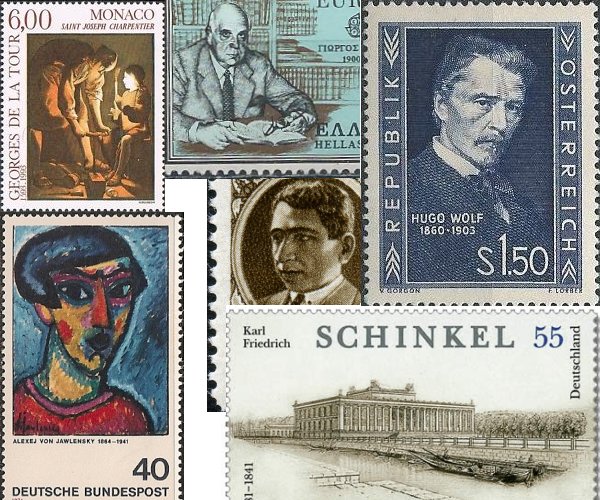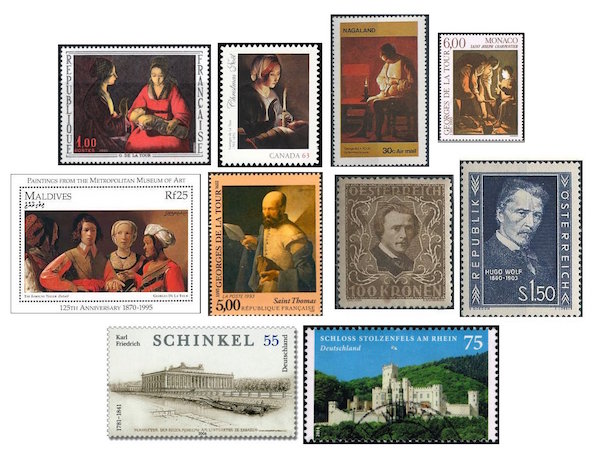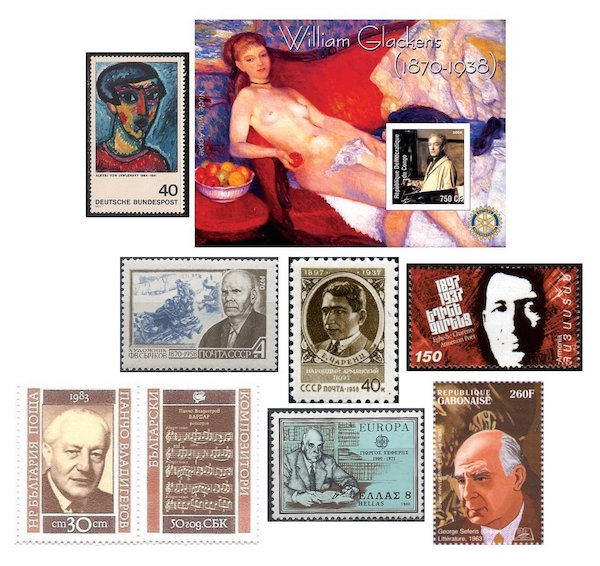The Arts on the Stamps of the World — March 13
An Arts Fuse regular feature: the arts on stamps of the world.

By Doug Briscoe
Famous creative artists born on March 13th and represented on stamps include two painters, Georges de La Tour and William Glackens, and two composers, Hugo Wolf and Pancho Vladigerov. In addition, we’ll see stamps for German architect Karl Friedrich Schinkel, Russian painters Alexej von Jawlensky and Fedot Sychkov, and poets Yeghishe Charents of Armenia and Nobel Prize winner George Seferis of Greece.
The most characteristic feature of the work of Georges de La Tour (March 13, 1593 – January 30, 1652) is the illumination by a single candle of intimate indoor night scenes. Four of our six de la Tour stamps show examples of this striking effect, though in one, The Newborn Child (1640s), the candle itself is out of sight. Next to that we have Saint Anne with the Christ Child (c1645-50), this a new 2013 Christmas stamp fron Canada, Joseph the Carpenter of 1642, perhaps the best known of these, and The Flea-Catcher (1638). (Philatelic note: This last is on an issue from the Indian state of Nagaland. It’s what we call a “Cinderella”, that is, a stamp issued by nonnational entity, in some cases for local use only.) In the next row we leave the candles behind for The Fortune Teller (1633-39) and Saint Thomas (1625-30).
Hugo Wolf (1860 – 22 February 1903) was born in what today is Slovenia. He was a child prodigy, but had no interest in subjects other than music and was expelled from or voluntarily left three schools before being kicked out of the Vienna Conservatory. Moody and often depressed, he was only sporadically employed, but with help was able to make a living teaching and composing. Although primarily remembered for his many great Lieder, I must confess that my favorite among his works is the delicious Italian Serenade of 1887. (At this time he was also working on a series of settings of poems by Eichendorff, whose birthday was just three days ago.) Wolf came to a tragic end in syphilitic madness after admitting himself to a Vienna asylum. His lover Melanie Köchert, the wife of his friend, committed suicide three years later. Arthur Schnitzler might have made one of his great stories about it. The Wolf stamps are both from Austria; the one on the left (“100 Kronen”) is from a set of stamps issued in 1922, the oldest stamps in the world to honor composers (where else but Austria?), and the later one came out in 1953, the fiftieth anniversary of the composer’s death.

Prussian architect Karl Friedrich Schinkel (13 March 1781 – 9 October 1841) worked mainly in Berlin, near the place where he was born, Neuruppin. That town suffered a catastrophic fire when Schinkel was six in which his father died. He studied architecture but his earliest work was as a painter and set designer (his 1816 design for a production of Mozart’s Magic Flute has served as a model for that opera down to this day). He gave up the brush after seeing one of Caspar David Friedrich’s paintings and committed to a life in architecture, at first turning to renovations of existing buildings. He prepared a draft, for example, for the reconstruction of the ruins of Stolzenfels Castle on the Rhine (see the stamp with the color photograph). Most of Schinkel’s concepts through the 1820s were neoclassical with an inclination toward the Greek rather than the Roman (he provided plans for the proposed transformation of the Acropolis in Athens into a new royal palace!) but, perhaps with the example of Stolzenfels in the back of his mind, he built the first neogothic church in Berlin, the New Altstadt Church, Further examples include the Friedrichswerder Church and the Bauakademie (Building Academy). The other stamp shows us his Altes Museum. Schinkel was also a city planner and furniture designer. On his Wikipedia page you can see several of his paintings and other buildings.
Russian painter Alexej von Jawlensky (yahv-LEN-ski; 1864 – 15 March 1941) studied at the art academy in St. Petersburg and was patronized by a wealthy former student of Ilya Repin who gave up her own career as an artist to further Jawlensky’s. In 1894 he relocated to Munich, where he would meet Kandinsky and join the New Munich Artist’s Association and, later, the famous Blaue Reiter group. As a Russian, he was given his walking papers when World War I broke out and moved to Switzerland, but returned to Germany in 1922 to take up residence in Wiesbaden. With Kandinsky he was one of the founders in 1923-24 of Die Blaue Vier (the Blue Four), which exhibited in Germany and the US. From 1929 Jawlensky began to suffer from arthritis, and he was unable to paint after 1937. An interesting side note is that each of the six volumes of the complete string quartets of Mieczyslaw Weinberg on CPO CDs has a Jawlensky portrait on the cover. The German stamp of 1974 shows a seventh.
American painter William Glackens (1870 – May 22, 1938) was born in Philadelphia, where he was an artist-reporter for two newspapers in the early 1890s. He became an habitué of the gatherings at the studio of Robert Henri that formed the basis of the Ashcan School, so-called for its urban street scenes. Glackens painted a wide variety of subjects, however, and in a variety of styles. For Glackens we have a souvenir sheet from the Democratic Republic of the Congo highlighting his Nude with Apple of 1910 with an insert of a photograph of the artist.
Our third consecutive painter is again a Russian, Fedot Sychkov (1870 – August 3, 1958). Born in poverty, he learned how to paint in an icon school. One of his pieces was done for an appreciative general who paid for Sychkov’s continued education in Saint Petersburg. He, too, like Jawlensky, had the opportunity to study under Repin. By 1900 Sychkov was a popular portrait painter. He traveled to Italy and France in 1908 and returned to the region of his birth, Penza, where he mostly painted peasant scenes and especially children, later moving smoothly into post-Revolutionary Socialist Realism. Our only Sychkov stamp, from the USSR, gives us just a hint of his work, a typical example, as can be seen on a nice YouTube video of his pieces. The painting of the stamp, the title and date of which I wasn’t able to determine, shows up on the video at about 4:05.
Now we come to today’s first poet, the Armenian Yeghishe Charents (yeh-ghi-SHEH char-YENTS; March 13, 1897 – November 27, 1937), seen on a Soviet stamp from 1958 and a much more recent one from Armenia. He had his first poem published when he was only 15. As a soldier in the Armenian army in World War I, he was witness to aspects of the genocide in the devastation of Van. On leaving the front, he went to university in Moscow and became an ardent Bolshevist, fighting with the Reds in the Russian Civil War, but later firmly renouncing Stalinism, to which he himself fell victim in the purges. He died in a prison hospital. His works lived on in translations by such figures as Anna Akhmatova and Boris Pasternak. William Saroyan visited him in 1934, and one of his last works was a memorial to the composer Komitas, who died in 1935. Many Armenians regard Charents as their national poet.

Pancho Vladigerov (vlah-dee-GAIR-off; 1899 – 8 September 1978), a Bulgarian, was born and lived in Switzerland up to the age of 11, when on the death of his father the family returned to Sofia. He was much influenced by his Russian-Jewish grandfather, a polymath who composed, taught mathematics, and was a champion chess player. At thirteen, Vladigerov went to Berlin to study under Paul Juon and others. He worked at the Deutsches Theater with Max Reinhardt and, after having achieved fame throughout Europe as a composer and pianist in the 1920s, returned again to Sofia in 1932. One of his students was Alexis Weissenberg. Vladigerov is held to be perhaps the greatest composer from Bulgaria, where his Vardar (or Bulgarian) Rhapsody (1928) is his most celebrated work, thought by some to be the spiritual equivalent of Chopin’s “Heroic” Polonaise for the Poles. The Vladigerov stamp, which is attached to a label showing the Vardar theme, was given to me by no less a personage than Marc-André Hamelin!
We return to poetry for today’s final subject, Nobel laureate Giorgos or George Seferis (seh-FAIR-iss; March 13 [O.S. February 29] 1900 – September 20, 1971), whose birth name was Seferiades. He was born and grew up in what was then part of the Ottoman Empire, but the family moved to Athens when he was 15. Later he studied law at the Sorbonne. As a result of conflict in Anatolia, there was an exodus of Greeks from the region, and in consequence Seferis felt the alienation of being severed from his place of birth and childhood for many years. (He didn’t return for a visit until 1950.) Seferis became a diplomat, assigned to Britain and Albania, and was able to escape the German invasion of Greece to join the government in exile. After the war he visited and fell in love with Cyprus, which in some respects reminded him of his childhood home near Smyrna and inspired his first poems after a fallow period of some six or seven years. He won the Nobel Prize in 1963, the first Greek to do so. His poem “Denial” was set by Mikis Theodorakis and sung, in spite of a ban, by the large crowds at his funeral.
A graduate of the University of Massachusetts with a B.A. in English, Doug Briscoe worked in Boston classical music radio, at WCRB, WGBH, and WBUR, for about 25 years, beginning in 1977. He has the curious distinction of having succeeded Robert J. Lurtsema twice, first as host of WGBH’s weekday morning classical music program in 1993, then as host of the weekend program when Robert J.’s health failed in 2000. Doug also wrote liner notes for several of the late Gunther Schuller’s GM Recordings releases as well as program notes for the Boston Classical Orchestra. For the past few years he’s been posting a Facebook “blog” of classical music on stamps of the world, which has now been expanded to encompass all the arts for The Arts Fuse.
